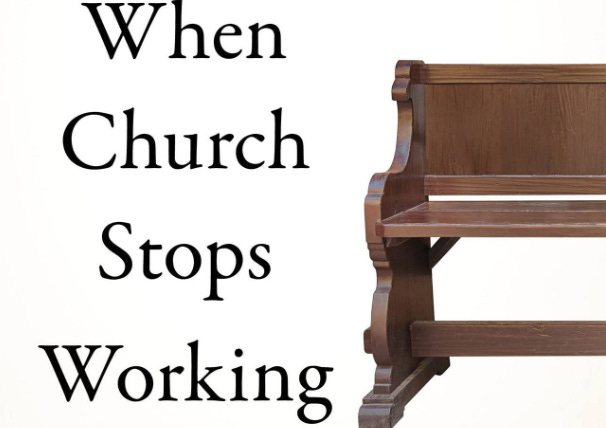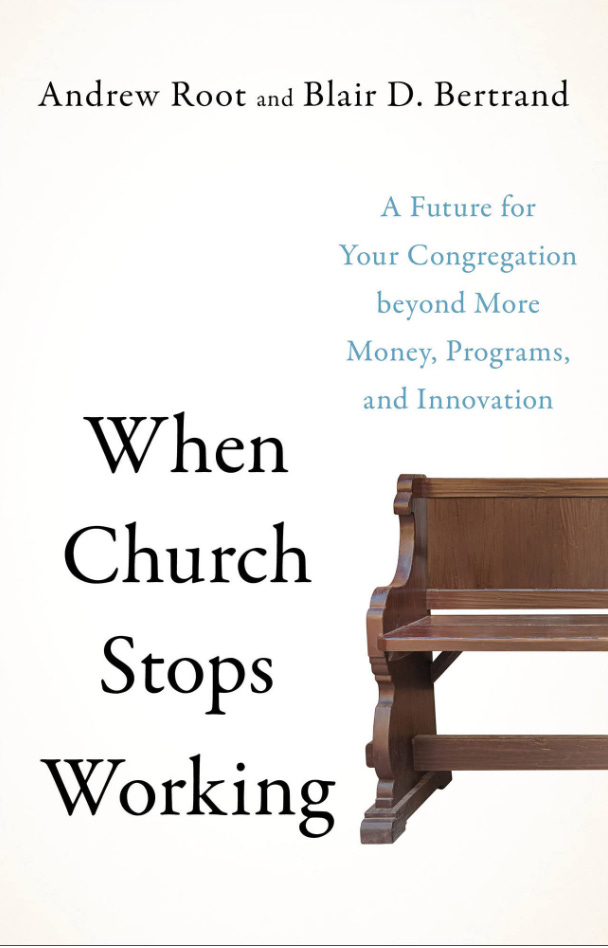A title like When Church Stops Working will attract plenty of readers, and even more will join the crowd of readers with the subtitle A Future for Your Congregation beyond More Money, Programs, and Innovation. The book is by Andrew Root and Blair D. Bertrand. Root is known for his Ministry in a Secular Age, which takes the famous work by Charles Taylor and works it out page after page over three volumes.
Many have met the wall that calls for better preaching, bigger budgets, and cleverer ideas, and that wall has shown them something else is needed. For those who have not read Taylor’s A Secular Age, he has a short set of lectures called The Ethics of Authenticity and it can be an introduction to his larger project. Taylor convinces most of his readers that something bigger is at work – we are in a secular age in which belief in God and a church life have lost their instinctual attraction to postmoderns.
And those who do not have that instinct, it doesn’t seem to matter. At one time one could “guilt” a person into awakening that sleeping instinct, but today many can’t be awakened because they don’t have that instinct. Here I’m trying to express some of the secular age theme.
Root mastered Taylor long ago because he knew he was a portal into coming to terms with pastoral ministry in our age. So he wrote three volumes, and this new When Church Stops Working is a more accessible version of those three volumes.
He probes and probes. Conservatives long for the glory days and liberals dream of future days, but we live in the now, not the past or the future. The goal of “making the first church of somewhere great again” runs parallel to the secular age and makes use of a secular imagination that doesn’t appeal to the current age.
The not enough for both sides pertains to “too little influence” and “too few people” and “too fragile belief.” Both want “more” but the more-ness theme is indelibly stamped on them by secularity.
Innovate, innovate, innovate: more resources, more relevance. Without the former, we can’t get the latter; without the latter, we can’t get the former. So, many copy successful churches who innovated into relevance and attractiveness. Root and Bertrand contend “effective innovation” has not changed in fifty years as the solution, and the solution has not made things better.
The books from the 1970s to the 2020s advocating for effective innovation into attractive relevance have been pressing against the wrong problem. Influence, people, and belief are symptoms of the problem, not the problem. ‘
The problem is the secular age.
The symptom of less influence is shaped by the fact that the “sacred no longer sets the agenda for all of society.”
The symptom of less people is shaped by a divide in the “public and the private.” Society is fine and dandy without the sacred and this means religion is now optional.
The symptom of fragile belief connects to the reality that belief has changed. Symptom 1 and 2 shape Symptom 3: less sacred and less public faith are part of a “wide assortment of beliefs,” the most significant of which is “it is now possible to not believe in God.” Yes, the world is no longer enchanted for most.
These are the marks of the secular age.
The solutions are part of the secular age rather than part of a sacred world.
The secular age has “captured our imaginations.”
“If you want a healthy church, you are going to need to imagine a cure that doesn’t depend on the secular age.”
Root and Bertrand:
Because the secular age separates the secular and the sacred, making belief private and the immanent the agreed-upon public reality, the church has a hard time imagining what a public faith that witnesses to the transcendent looks like. Our imaginations are secular, so when we try to imagine the sacred, try to see God at work in our lives and in the world, we can do so only in secular terms. … It is as if we have looked at the world with a secular lens for so long that when something sacred appears, we can't see it for what it is, nor do we even have the language to describe it.
They contend that the secular age’s drive for efficiency and acceleration need to be countered with a capacity for resonance with the sacred.
Resonance is an experience of fullness, of being In Sync, of being so present to someone or something else that we feel like we have discovered ourselves again. We can resonate with something whether we are moving fast or slow. Often resonance is timeless. … Or the moment is so full, so powerful, that something that takes seconds feels much longer period resonance is all about connecting with the world, with the people in our lives, and finding a meaning that is greater than what we can see and explain. Resonance is about the sacred, the public, and the transcendent.
We want to do something about it. Jesus told his disciples to wait.






What came to mind was Dr. Bruce Perry's concern about the empathy. This talk is about "why empathy is essential and endangered". https://www.youtube.com/watch?v=5gU1wXbs5mc
Since God is love, as people move farther away from goodness, love/care for others, it makes sense they will also be moving away from sacred. And be harder to influence toward sacred because they have no experience of care. Basic attachment theory. Their experience is early formation by "care" givers who did not care about their emotional needs. So they do not have the experience to be drawn toward the sacred.
All that being said Roman times were exactly like this secular discription. It's not hopeless. It's do we recognize Holy Spirit inside of each of us and risk in the possiblity of violent conversations? I see it more as a shift from organization to face to face relating. Christ followers have to be willing to have more skin in the game. It will be painful. It wasn't that easy to get nailed to the cross.
When I read this review, it resonates. It's like the story of the young Samuel serving Eli. Samuel is awakened by God calling his name, and thinks it is Eli, but Eli says no, and sends Samuel back to bed. The third time this happens, Eli catches on, and tells Samuel to respond, "Speak, Lord, your servant is listening." It happens again, and Samuel does as Eli instructed. God then speaks to Samuel. Two things from this story: First, Samuel does not recognize God's voice. Second, Samuel lacks the language to respond. That aptly describes the world I live in as a pastor in Maine. People don't recognize God, and even if they do, they lack the language or concepts to access that recognition. Perhaps we have to wait until people describe a "Samuel experience," then give them a way of responding. (BTW, the message Samuel heard was not what Eli would have liked.)